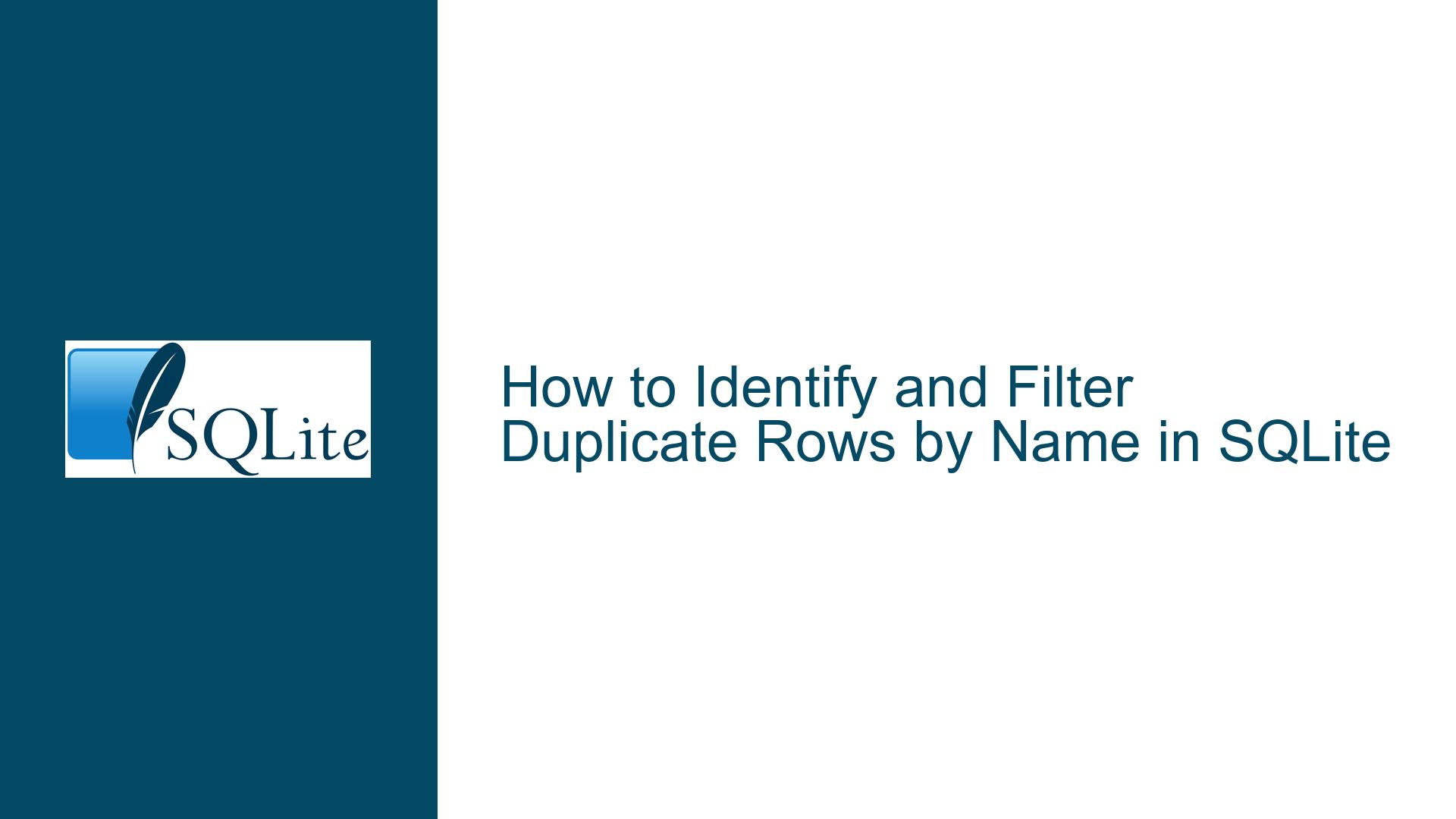How to Identify and Filter Duplicate Rows by Name in SQLite
Understanding Duplicate Name Detection in a Unique Identifier Schema
The core challenge involves identifying duplicate entries based on a non-unique name column within a table structure containing unique personal identifiers. This scenario typically occurs in databases storing personnel records where individual uniqueness is enforced through an artificial primary key (person_no) while allowing natural name duplicates. The table structure follows this pattern:
CREATE TABLE person (
person_no TEXT PRIMARY KEY,
name TEXT,
birthday TEXT
);
Sample data demonstrates the fundamental issue:
person_no | name | birthday
----------|--------|-----------
01 | John | 01/01/2000
02 | John | 15/03/2000
03 | Marry | 21/06/2000
04 | Peter | 23/12/2000
05 | Jerry | 12/07/2000
The operational requirement demands listing complete records for all individuals sharing names with others, while preserving the unique person_no distinction. This creates a conflict between primary key enforcement and natural data duplication patterns, requiring specialized query techniques to surface duplicate relationships without modifying underlying uniqueness constraints.
Structural Limitations Enabling Name Duplication in Unique Key Systems
The persistence of name duplicates stems from intentional database design choices prioritizing identifier uniqueness over natural key constraints. Three architectural factors enable this situation:
Absence of Composite Uniqueness Constraints
The schema deliberately avoids UNIQUE constraints on name/birthday combinations or other natural key candidates. This design permits unlimited name duplication while maintaining person_no as the sole unique identifier.Business Logic vs Database Enforcement Dichotomy
Applications may handle name uniqueness requirements through procedural code rather than database-level constraints. This approach introduces potential race conditions and requires explicit duplicate detection mechanisms.Temporal Data Variance Considerations
Birthday discrepancies between same-name individuals (as seen in the two John entries) prevent effective use of composite keys. The temporal element introduces valid data variations that complicate duplicate prevention strategies.
These structural characteristics necessitate programmatic duplicate identification rather than constraint-based prevention. The challenge intensifies when dealing with large datasets where manual verification proves impractical, requiring optimized query patterns to balance performance with accuracy.
Comprehensive Duplicate Identification Techniques and Optimization Strategies
Self-Join Pattern for Pairwise Duplicate Analysis
The autojoin technique reveals duplicate relationships through table self-referencing:
SELECT a.person_no AS left_id,
b.person_no AS right_id,
a.name AS shared_name,
a.birthday AS left_birthday,
b.birthday AS right_birthday
FROM person a
INNER JOIN person b
ON a.name = b.name
AND a.person_no < b.person_no;
Execution Dynamics:
- Creates Cartesian product limited to matching names
- Inequality condition (
a.person_no < b.person_no) prevents duplicate mirror pairs - Returns distinct pairs rather than individual records
Performance Considerations:
- Time complexity grows quadratically (O(n²)) with duplicate group size
- Requires temporary storage for join results
- Index on name column reduces comparison overhead
Result Set Characteristics:
left_id | right_id | shared_name | left_birthday | right_birthday
--------|----------|-------------|---------------|----------------
01 | 02 | John | 01/01/2000 | 15/03/2000
Optimization Tactics:
- Materialize results into temporary table for batch processing
- Combine with EXISTS clause to eliminate redundant comparisons
- Use covering indexes to minimize disk I/O:
CREATE INDEX idx_person_name ON person(name) INCLUDE (birthday);
Grouped Aggregation with HAVING Clause Filtering
The subquery aggregation method provides duplicate groups rather than individual pairs:
SELECT name,
COUNT(*) AS duplicate_count,
GROUP_CONCAT(person_no, ', ') AS identifiers,
GROUP_CONCAT(birthday, '; ') AS birth_dates
FROM person
GROUP BY name
HAVING COUNT(*) > 1;
Output Structure:
name | duplicate_count | identifiers | birth_dates
-------|-----------------|-------------|-------------------------
John | 2 | 01, 02 | 01/01/2000; 15/03/2000
Implementation Nuances:
- GROUP_CONCAT limits configurable through SQLITE_LIMIT_LENGTH
- Collation sequence affects name grouping (case sensitivity)
- HAVING clause executes after aggregation, unlike WHERE
Performance Enhancements:
- Utilize covering index for grouped queries:
CREATE INDEX idx_person_name_covering ON person(name, person_no, birthday);
- Adjust buffer size for large concatenations:
PRAGMA group_concat_max_len = 1000000;
Window Function Approach for Individual Record Tagging
Modern SQLite versions (3.25.0+) support window functions for efficient duplicate marking:
WITH dup_marker AS (
SELECT *,
COUNT(*) OVER (PARTITION BY name) AS name_count
FROM person
)
SELECT person_no, name, birthday
FROM dup_marker
WHERE name_count > 1
ORDER BY name, person_no;
Execution Plan Benefits:
- Single table scan with streaming aggregation
- No temporary storage for join results
- Parallel processing compatible in some environments
Result Format:
person_no | name | birthday
----------|------|----------
01 | John | 01/01/2000
02 | John | 15/03/2000
Advanced Variations:
- Add dense_rank() for duplicate numbering:
SELECT *,
DENSE_RANK() OVER (PARTITION BY name ORDER BY person_no) AS dup_seq
FROM person;
- Combine with UPDATE statements to flag duplicates:
ALTER TABLE person ADD COLUMN is_duplicate BOOLEAN DEFAULT 0;
UPDATE person
SET is_duplicate = 1
WHERE person_no IN (
SELECT person_no
FROM (
SELECT person_no,
COUNT(*) OVER (PARTITION BY name) AS cnt
FROM person
) WHERE cnt > 1
);
Hybrid Approaches for Complex Duplicate Scenarios
Combine multiple techniques for enhanced duplicate resolution:
Scenario: Identify name duplicates with conflicting birthday entries
WITH base AS (
SELECT name,
COUNT(DISTINCT birthday) AS unique_bdays,
GROUP_CONCAT(person_no) AS ids
FROM person
GROUP BY name
HAVING COUNT(*) > 1
)
SELECT p.*
FROM person p
JOIN base b
ON p.name = b.name
WHERE b.unique_bdays > 1;
Analysis:
- First identifies names with multiple birthdays
- Then retrieves detailed records for those cases
- Uses CTE for intermediate result clarity
Performance Benchmarking Considerations:
- Create test dataset with controlled duplicate ratios
- Execute each method with EXPLAIN QUERY PLAN
- Measure memory usage via SQLITE_STATUS_MEMORY_USED
- Profile disk I/O with sqlite3_analyzer tool
Index Optimization Matrix:
| Method | Recommended Index | Notes |
|---|---|---|
| Self-Join | (name) INCLUDE (person_no, birthday) | Covering index avoids table scans |
| Grouped Aggregation | (name, person_no, birthday) | Optimizes both grouping and projection |
| Window Functions | (name) | Partition pruning efficiency |
Collation and Case Sensitivity Handling:
-- Case-sensitive duplicate detection
SELECT name
FROM person
GROUP BY name COLLATE BINARY
HAVING COUNT(*) > 1;
-- Case-insensitive grouping
CREATE TABLE person (
name TEXT COLLATE NOCASE
);
Temporal Data Considerations:
- Store birthdays in ISO 8601 format (YYYY-MM-DD) for proper sorting
- Use date functions for age calculations:
SELECT name,
strftime('%Y', 'now') - strftime('%Y', birthday)
- (strftime('%m-%d', 'now') < strftime('%m-%d', birthday))
AS age
FROM person;
Concurrency and Locking Implications:
- WAL mode recommended for concurrent duplicate scans
- Use IMMEDIATE transactions for write operations during analysis
- Avoid schema changes during detection processes
Statistical Analysis Extensions:
- Calculate duplicate prevalence ratios:
SELECT
(SELECT COUNT(*) FROM person) AS total,
(SELECT COUNT(*) FROM (SELECT name FROM person GROUP BY name HAVING COUNT(*) > 1)) AS dup_groups,
(SELECT SUM(cnt) FROM (SELECT COUNT(*) AS cnt FROM person GROUP BY name HAVING COUNT(*) > 1)) AS dup_entries;
Data Cleaning Integration:
- Export duplicates for review:
ATTACH DATABASE 'review.db' AS audit;
CREATE TABLE audit.duplicates AS
WITH duplicates AS (
SELECT *, ROW_NUMBER() OVER (PARTITION BY name ORDER BY person_no) AS rn
FROM person
)
SELECT * FROM duplicates WHERE rn > 1;
- Implement soft deletion cascade:
UPDATE person
SET is_active = 0
WHERE person_no IN (
SELECT person_no
FROM (
SELECT person_no,
ROW_NUMBER() OVER (PARTITION BY name ORDER BY person_no) AS rn
FROM person
) WHERE rn > 1
);
Long-Term Prevention Strategies:
- Implement application-level duplicate checks
- Add audit triggers for name changes:
CREATE TRIGGER trg_name_change
AFTER UPDATE OF name ON person
FOR EACH ROW
BEGIN
INSERT INTO name_changelog
VALUES (OLD.person_no, OLD.name, NEW.name, datetime('now'));
END;
- Schedule periodic duplicate scans via cron jobs or event triggers
- Consider probabilistic data structures for approximate duplicate detection
Cross-Platform Compatibility Notes:
- Window function syntax varies across DBMS (e.g., MySQL vs SQLite)
- GROUP_CONCAT implementation differences in sort order and separators
- Date formatting functions require adaptation for non-SQLite environments
Advanced Diagnostic Queries:
- Identify duplicate patterns across multiple columns:
SELECT name, birthday, COUNT(*)
FROM person
GROUP BY name, birthday
HAVING COUNT(*) > 1;
- Locate near-duplicates with soundex:
SELECT a.name AS name1, b.name AS name2,
difference(a.name, b.name) AS similarity
FROM person a
JOIN person b
ON a.person_no < b.person_no
WHERE soundex(a.name) = soundex(b.name);
Security Considerations:
- Sanitize input parameters in dynamic queries
- Limit result sets for web interfaces:
SELECT *
FROM person
WHERE name IN (SELECT name FROM person GROUP BY name HAVING COUNT(*) > 1)
LIMIT 100;
- Encrypt sensitive personal data columns
Alternative Storage Architectures:
- Virtual tables for full-text search integration
- External content tables with FTS5
- Sharded databases based on name hashes
Machine Learning Integration Patterns:
- Export duplicate sets for model training:
COPY (
SELECT name, COUNT(*) OVER (PARTITION BY name) AS dup_count
FROM person
) TO 'dupes.csv' WITH CSV HEADER;
- Implement clustering algorithms via SQL extensions
This comprehensive guide provides multiple pathways for duplicate resolution in SQLite environments, balancing immediate detection needs with long-term prevention strategies. Each method carries distinct performance characteristics and suitability profiles depending on dataset size, query frequency, and operational constraints.






